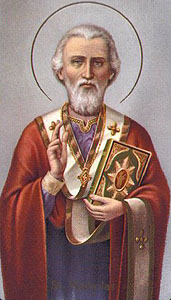
Feast day of St Nicholas of Myra (Santa Claus)
“The Gnostic followers
of St Nicholas, the Nicolaites, taught that the only way
to salvation
lay through frequent sexual intercourse. In Northern Europe,
St Nicholas
absorbed Pagan attributes from Woden (Odin), chief of the
wild hunt, who
rides through the sky with reindeer and forty-two
supernatural
huntsmen. Since the Reformation, this saint has become
merged with
the Father Christmas of Yuletide. The modern Santa Claus
also has elements
of Thor, traditionally depicted riding a goat and
carrying a wassail
bowl.” (Pennick 1992, 136)
“One of the most popular
saints in Christendom, especially in the East. He is
the patron saint
of Russia, of Aberdeen, of parish clerks, of scholars
(who used to
be called clerks), of pawnbrokers (because of the three
bags of gold
- transformed to the three gold balls - that he gave to
the daughters
of a poor man to save them from earning their dowers in
a disreputable
way), of little boys (because he once restored to life
three little
boys who had been cut up and pickled in a salting-tub to
serve for bacon),
and is invoked by sailors (because he allayed a storm
during a voyage
to the Holy Land) and against fire. Finally he
is the original
of Santa Claus.
Little is known
of his life but he is said to have been Bishop of Myra (Lycia)
in the early
4th century, and one story relates that he was present at the Council of
Nicea (325)
and buffeted Arius on the jaw. His day is 6 December, and
he is represented
in episcopal robes with either three purses of gold,
three gold balls,
or three small boys, in allusion to one or other of
the above legends.”
(Evans 1988)
[NB Pawnbrokers
are said to have taken the three golden balls from the armorial
signs of the
Medici of Florence, which in turn derived them from the St Nichlas legend
- PW.]
When he died
his body was buried in the church at Myra. in 1087, following schism between
Roman and Greek
Orthodox Churches, Italians took his bones to Bari,
where he remains.
The ruined tomb attracts many visitors, especially on this day.
When he was a breastfeeding
baby he fasted on Wednesdays and Fridays [the fast
days appointed by
the church] .
Legend of the 3
dowries
A nobleman of Patara
had three daughters; he was so poor he couldn't
provide their
dowries and they were going to have to go into
prostitution.
St Nick had inherited a large fortune, and he resolved
to help, but
secretly. As he went to their house at night, wondering
how to do this,
the moon came out from behind a cloud and lit up a
window through
which he threw a bag of gold, which fell at the girls'
father's feet.
This enable him to provide a dowry for his first daughter.
The next night, St
Nicholas threw in another, and thus
procured a dowry
for the second daughter. The father wanted to see the
benefactor,
so on the third night he saw St Nick coming and grabbed
his cloak, saying
"O Nicholas! servant of God! why seek to hide thyself?"
The saint made
him promise not to tell anyone. From this
came the custom
on St Nicholas's eve of putting out presents for
children. Pawnbrokers
probably took their symbol from his three gold
balls or bags
of gold.
Legend of the evil
innkeeper
A gentleman of Asia
sent his two sons to Athens for education,
and had them
stop to see the holy Archbishop of Myra, St Nicholas.
They stayed
in an inn where the keeper chopped them up and salted them
down like bacon.
St Nick was warned of this in a terrible vision and
went and charged
the landlord with the crime. He confessed with
contrition and
asked the forgiveness of Heaven. Nichlas granted
him this and
also restored the boys. In art, St Nick is often shown
next to a tub
with tanked children in it.